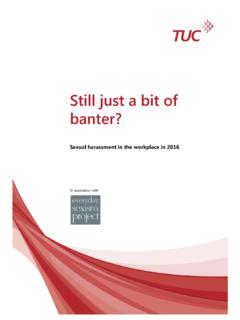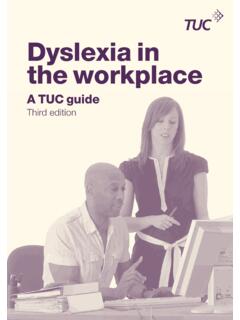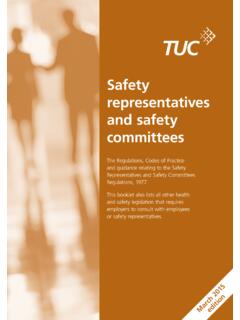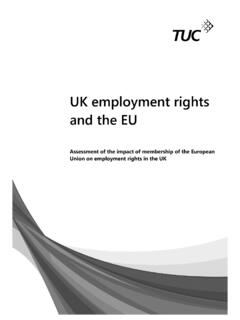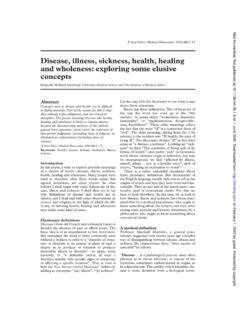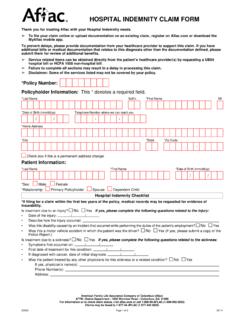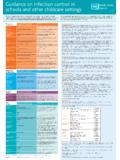Transcription of Sickness Absence and Disability Discrimination Feb 2013
1 Date: February 2013 Sickness Absence and Disability Discrimination A trade union negotiator's guide to the law and good practice Trades Union Congress Sickness Absence and Disability Discrimination 2 Contents 3 Section 1: Summary 6 Section 2: The legal position What the law says Sickness Absence : the case law Sickness Absence , sick pay and Disability The Code of Practice Reasonable Adjustments The Equality Duty Conclusions 16 Section 3: Good Practice Presenting the business case Counting Disability separately Occupational Health Disclosure Organising benefits 22 Section 4: Disability Leave 25 Section 5: Appendices 1. Unison model Disability Leave agreement 2. PCS model agreement 3. An actual Disability Leave agreement 4. Other TUC resources Trades Union Congress Sickness Absence and Disability Discrimination 3 Section 1 1 Summary The Equality Act 2010 ( EqA ) replaced the Disability Discrimination Act 1995 ( DDA ) when it came into force in 2010.
2 The DDA provisions were carried over into the EqA and were strengthened. The DDA which had been regularly revised and substantially improved over the years culminating in the enactment of the Disability Discrimination Act (DDA) 2005, created important legal protections against Discrimination for workers who met the law s definition of Disability . As a result of the law and of growing awareness of its existence, more than a decade later it has become more unusual for disabled workers to face dismissal or unequal treatment for the simple reason of being disabled, especially among larger employers. Nonetheless, ignorance of the detail of the DDA and now of the EqA remains widespread, and among other issues, unions have reported throughout this time that employers are continuing to get rid of disabled workers by using their Sickness Absence , capability or other procedures, without taking due account of the Disability .
3 In April 2008, the TUC organised a well-attended seminar to explore solutions to the Sickness Absence problem. Catherine Casserley, barrister, formerly senior legal adviser at the Disability Rights Commission, explained how the law has been interpreted by the courts. Phil Madelin of PCS, Diana Holland of Unite and Jo Bird of USDAW each spoke of experiences, both positive and negative, from their own sectors. The participants in the seminar discussed their own experiences and it became clear that a number of key messages were emerging. One of the proposals emerging was for publication of TUC guidance. This document is therefore a first attempt to distil current case law and existing good practice into advice for union officers and workplace representatives. It has now been updated to take into account Trades Union Congress Sickness Absence and Disability Discrimination 4 the changes brought about by the passing and implementation of the EqA.
4 The central elements of this guidance are: The case law as it stands in relation to the payment of sick pay and Sickness Absence remains unhelpful, but the legal obligation on employers to consider reasonable adjustments for disabled workers is a vital concept that can be used as underpinning for negotiating changes to Absence procedures. In general, unions will be better advised to use the requirements of the EqA to resolve issues by persuading the employer to adopt progressive policies and procedures rather than going to tribunal. The Code of Practice associated with the EqA, with accompanying guidance, and the previous Code of Practice associated with the DDA, contain some useful advice that can be cited in convincing employers of the need to adopt a new approach, as well as being usable in tribunal proceedings. Lack of understanding of the principles of Disability Discrimination law remains a serious problem with numerous employers, managers and union representatives and training in (as a minimum) what the EqA requires is vital if genuine progress is to be made.
5 In the public sector, the incorporation of the 2006 Disability Equality Duty into the Equality Act puts even greater emphasis on improving awareness of Disability , and changing policies accordingly. The law should be of considerable assistance in this sector in changing practices and unions need to press for the maximum improvements in the employer s policies and procedures. The critically important starting point for changing an employer s approach is to get Absence for reasons associated with Disability counted separately from Sickness Absence . The other critical component of a non-discriminatory approach will be for the employer to adopt a Disability leave policy. However, it is the content of such a policy that will determine how useful it is in practice, so it is vital Trades Union Congress Sickness Absence and Disability Discrimination 5 to secure the best possible policy from the outset.
6 Other issues will have to be tackled for good policies to work, in particular that of persuading workers that it is in their interest to disclose their impairment. 2 Trades Union Congress Sickness Absence and Disability Discrimination 6 Section 2 3 The legal position What the law says The Equality Act 2010 (EqA) defines Disability as a physical or mental impairment that has a substantial and long term adverse effect on someone s ability to carry out normal daily activities. The definition includes people with hidden disabilities (such as diabetes, epilepsy, mental health), in particular because when considering the impact of someone s impairment you have to disregard the effect of any treatment, and progressive and recurring conditions. It also covers past disabilities. People with cancer, HIV and MS are automatically covered by the Act.
7 The definition is a very broad one potentially covering many millions of people, although it is important to note that many of those who are protected by the EqA are not aware that they are, and do not necessarily consider themselves to be disabled. This can raise issues of disclosure that are considered later in this guidance. The law specifies the forms of Discrimination that are outlawed: Direct Discrimination : that is, less favourable treatment because of Disability , compared to someone whose circumstances excluding the Disability are otherwise comparable. Such Discrimination cannot be justified by the employer. Discrimination arising from Disability : that is, treating someone less favourably because of something arising in consequence of a person s Disability . Such Discrimination is capable of legal justification by the employer if the treatment is a proportionate means of achieving a legitimate aim.
8 In addition, there will be no Discrimination if the employer shows that it did not know, and could not reasonably have been expected to know, that the person had Trades Union Congress Sickness Absence and Disability Discrimination 7 the Disability . This is a very broad type of Discrimination . Indirect Discrimination : this type of Discrimination happens when an employer applies a provision criterion or practice which puts or would put people with a different Disability at a particular disadvantage compared to people who share the disabled person s Disability ; it is applied to the disabled person; and the employer cannot show that it is a proportionate means of achieving a legitimate aim. This type of Discrimination has never previously applied to Disability . It is aimed at tackling group disadvantage, and can be used to tackle policies and practices that are inadvertently detrimental which may include Sickness Absence policies.
9 There is no knowledge requirement for indirect Discrimination . Failure to make a Reasonable Adjustment. This is one of the key components of the Disability provisions of the EqA. An employer is under a legal obligation to make reasonable adjustments to enable a disabled person to work or continue to work. There can be no justification for a failure to make a reasonable adjustment, but an employer is allowed to argue that an adjustment is not reasonable . There is a wide range of possible adjustments, including changes to physical aspects of premises and changes in someone s work duties. The DDA contained within it a list of possible adjustments that an employer might have to make. The EqA does not contain such a list, but the Employment Code of Practice which the Equality and Human Rights Commission has published to provide guidance for employers, employees and tribunals in how the provisions work does provide a list of possible adjustments.
10 These include Disability leave. The example given in the code of this is as follows: Example: A worker who has cancer needs to undergo treatment and rehabilitation. His employer allows a period of Disability leave and permits him to return to his job at the end of this period. Trades Union Congress Sickness Absence and Disability Discrimination 8 A Disability leave policy can include the provision of separate periods of time off for the purpose of (for example) treatment, therapy, rehabilitation, training or waiting for adjustments to be executed. The TUC and many Disability organisations have campaigned for this particular example of a reasonable adjustment to be included within the wording of the law itself, without success. The failure of the Government to propose such a change to the law underlies many of the problems faced by trade unions in persuading employers of the arguments for introducing such a policy.
